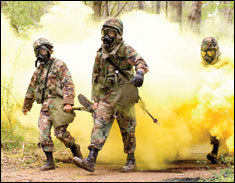MEDICAL MANAGEMENT OF CHEMICAL
CASUALTIES HANDBOOK
Third Edition, July 2000
INTRODUCTION
|
PURPOSE
Chemical warfare is not a popular topic, and most military health care providers do not willingly become familiar with it. This was painfully obvious during Operation Desert Shield/Desert Storm when it soon became apparent that many health care providers knew little about the effects of chemical agents or the medical defense against them. This ignorance was particularly striking in view of the seven-decade long history of modern chemical warfare and the well-publicized use of mustard and nerve agent during the Iran-Iraq War in the 1980s. The prevailing attitude of military health care providers was that chemical agents would be used only on Hmong, Afghans, Kurds, or similarly unprepared and unprotected groups of people. Further, many health care providers believed if chemical weapons were used the outcome would be disastrous, defense would be impossible, and the casualty rate and loss of life would be high.
Through education, however, medical professionals involved in Operation Desert Shield/Desert Storm learned that medical defenses were possible and effective, that chemical casualties could be saved and returned to duty, and that mortality could be minimized. Further, they realized that they might be the targets of chemical agents. More importantly, they rapidly learned that General Pershing's warning (written shortly after World War I) about chemical agents was still true: "...the effect is so deadly to the unprepared that we can never afford to neglect the question."
The purpose of this handbook is to provide medical personnel in the field a concise, pocket-sized reference source for the medical management of chemical casualties. It is not intended to be a definitive text on the management of chemical casualties. |
Contents
Introduction Pulmonary Agents Cyanide Vesicants Nerve Agents Incapacitating Agents Riot-Control Agents Decontamination Casualty Management in a Contaminated Area Chemical Defense Equipment Appendix A - Patient Decontamination Appendix B - Casualty Receiving Area Appendix C - Personnel Decontamination Station Appendix D - Toxicity Data Appendix E - Physicochemical Data Appendix F - Medical Equipment Set Appendix G - Summary Chart Appendix H - Glossary of Terms Index |
U.S. Army Medical Research Institute of Chemical Defense (USAMRICD)
Chemical Casualty Care Division
USAMRICD
MCMR-UV-ZM
3100 Ricketts Point Road
Aberdeen Proving Ground, MD 21010-5400
THIRD EDITION
July 2000
Home · Textbooks and Manuals · Videos · Lectures · Distance Learning · Training · Operational Safety · Search
This website is dedicated to the development and dissemination of medical information that may be useful to those who practice Operational Medicine. This website is privately-held and not connected to any governmental agency. The views expressed here are those of the authors, and unless otherwise noted, do not necessarily reflect the views of the Brookside Associates, Ltd., any governmental or private organizations. All writings, discussions, and publications on this website are unclassified.
© 2006 Medical Education Division, Brookside Associates, Ltd. All rights reserved
| Textbook 292 Pages 0.7 MB Download Now |
